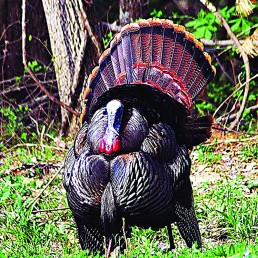Profile of a Gobbler
SHARE THIS POST
Humans call a male spring wild turkey a “gobbler,” but I believe that the best description is “survivalist.” Evolution has instilled an intense desire to stay alive into these ground-level-dwelling birds.
Hunters focus on the two main visual features of a gobbler’s body: its beard and spurs. Jakes—aka young toms—haven’t yet developed exceptional body features that excite hunters. And their prowess and wariness aren’t as unpredictable as mature toms.
A turkey’s body and wing feathers are waterproof and provide insulation. Dense feathers are a key feature that helps protect them. Ask any shotgun hunter who has tried to body-shoot a gobbler. A tom’s overlapping feathers act like a cushion, even when pelted by a load of heavy shot. Therefore, the best shot placement is a turkey’s head and neck.
A tom’s acute sense of sight and hearing usually contribute to self-preservation. Hunters quickly learn the value of these two senses and are often amazed by a turkey’s ability to judge their calling location, as well as detect their slightest movements.
Fortunately, gobblers don’t exhibit a keen sense of smell like most mammals, or they would be even more difficult to tag. Experienced wildlife biologists believe their sense of smell has little or no impact upon their daily habits.
Because turkeys are predominantly ground-dwelling birds, they require adequate escape methods. Like a wary whitetail buck, gobblers often stand motionless within dense habitats until a potential predator has moved on. If an intruder remains close by, a tom often escapes the location on foot. Turkeys can run at ground speeds of 12 m.p.h. or greater. And when pushed to the limit, they will take wing and fly at speeds between 45 and 55 miles per hour.
During early spring, turkeys feed heavily before breeding escalates. Diverse turkey diets provide growth stimulus and energy. Their diets are omnivorous, especially after cruel winter months, and they usually pursue soft foods as spring breaks: grasses, seeds, new-growth leaves, legumes, as well as leftover mast hidden under leaf cover. Earthworms, grasshoppers, spiders and a variety of insects satisfy their diet, too.
As spring sparks toms’ mating instincts, they begin to separate from their winter flock numbers. Most toms seek privacy as they pursue receptive hens. While it’s not unusual for two or more toms to hang together, their breeding status has already been determined by previous pecking order conflicts. Usually, only the most dominate toms will breed hens within their habitats. However, it’s not unusual for an interloping tom to slip into a location and steal hens. Even jakes sometimes have opportunities to breed hens if a mature tom is busy breeding others.
Are you enjoying this post?
You can be among the first to get the latest info on where to go, what to use and how to use it!
Watching a spring gobbler breed a hen is a unique experience. The beautiful, full-strut gobbler displays arrogant confidence. He might have gobbled to attract a hen or two, but once he’s joined with his hen(s) to engage in the mating process, he seldom gobbles. Hunters seldom hear toms gobble intensely after they leave their roosts during the prime mating weeks. Also, calling to a tom when he’s courting a hen can be futile, because he already has what he needs.
A tom’s mating actions are instinctively programmed. He often exposes himself on open landscapes, gobbling and strutting. This activity can last for an hour or two—sometimes longer if hens don’t appear. But when a hen is ready to breed, she goes to him. She often teases him by yo-yoing back and forth. Occasionally, she will rub against his chest and sides to excite him.
As soon as she’s ready to mate, she squats down to the ground into what is called the “sexual crouch.” She slightly spreads her wings across the ground and often wriggles her body, inviting him to breed. The tom will step up on her back and tread on her as he inseminates her. He might remain on her back for up to 8 to 10 minutes. When he dismounts, he often gobbles. She stands up, shakes her body and preens her feathers. Then, they each go their separate ways.
As you pursue gobblers throughout spring season, focus on hen locations. Gobblers are breeding machines and direct their energies at breeding every hen they can mount. That’s a tom’s role in life: breeding. Every other segment of his life takes second fiddle. Even eating, which is not a major priority during mating intensity. Toms have already been feeding heavily before mating and developed their breast sponge. This layer of fatty tissue is normally about three to four pounds in weight and helps sustain them during the demanding physical rigors throughout breeding activities. That’s why gobblers display very large breasts in early spring.
The more we know about spring turkey gobblers, the better our opportunities of scoring. Hunters soon learn that knowledge of their quarry makes them more successful, and that gobblers typically act and react differently during mating than at other times of the year.
For more turkey hunting insight from the pros who know, check out the April issue of MidWest Outdoors, available by subscribing on our website.
MWO
SHARE THIS POST
You may also like...
Nothing found.
Did you enjoy this post?
You can be among the first to get the latest info on where to go, what to use and how to use it!
Bob Grewell
Bob “Greenie” Grewell has written about and photographed the outdoors for 40 years. He’s travelled throughout the U.S., Canada, the Arctic Circle, as well as Germany and Denmark. He has written a book on hunting dogs and contributed articles and photography to others. He currently focuses on deer and turkey articles, and wildlife photography.
